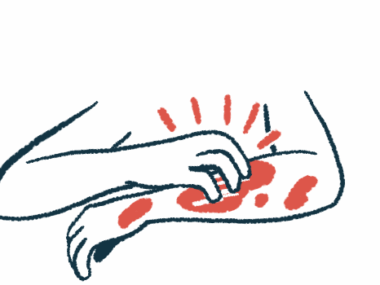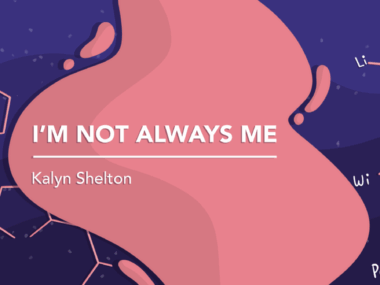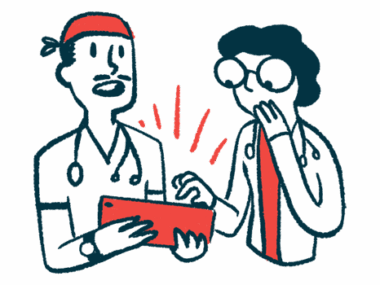How I’ve Found Peace During Endless Nights of Insomnia
Written by |

I don’t want to brag, but one time I was awake for eight days straight.
I was hospitalized with an acute hepatic porphyria (AHP) attack, but didn’t yet have a name for what was going on. To say it was a nightmare would be cruel, because I would’ve made sacrifices to the gods of sleep for a dream of any kind. Those eight days were part of the most challenging stretch of AHP I’ve ever endured.
I was hospitalized because my digestive system had shut down. My insides were silent. I couldn’t eat or drink, and the pain was indescribable. Throughout my stay, my care team could find no medical explanation for my symptoms, which are largely invisible.
AHP presents with a host of symptoms resembling other gastrointestinal, gynecological, neurological, and neuropsychiatric disorders. Among them is insomnia. Sleepless nights are a prodrome for me, a yellow flashing light indicating the inevitability of a flare. It often persists throughout the duration of an attack, and as the frequency of my flares disrupts my sleep routine, my insomnia is also chronic.
In my hospital bed, I listened to podcasts and audiobooks into the wee hours of the morning, including a Marc Maron interview with former President Barack Obama, another with actress and director Lena Dunham, a podcast that read children’s bedtime stories, and a Liane Moriarty novel. I took medication to help with anxiety and another to induce sleep. When nothing worked, my night nurse placed a lavender-soaked cotton ball on my pillow.
I hadn’t yet learned the “Spoonie” pro tip of packing my own blanket, but it wouldn’t have made a difference. Under those starchy covers, the only choice I had was to patiently wait for sleep to find me.
A history of insomnia
Bedtimes are a nice idea in theory, and I attempt to adhere to them. But even by practicing rigid sleep hygiene, I’m unable to magically become tired at the designated time. I’ve navigated this challenge since adolescence. Like so many with active AHP, puberty ushered in my symptoms.
The advent of AOL instant messenger occurred right alongside my struggle for sleep. Soon, I found the friends on my buddy list who were also up past their bedtimes.
When my insomnia started, it didn’t interfere with my daily life right away. In fact, I felt wired and alert the day after a sleepless night. It’s the subsequent nights that get to me, the sustained pattern of insomnia. This is still true in my adult life.
Over time, being awake all night became less of a one-off and more of a regularity, an unwanted yet expected occurrence. Both of my parents had trouble sleeping, and for a long time I reasoned that I inherited the trait. Once misdiagnosed with fibromyalgia, insomnia was further supported.
Surrendering to the night
Insomnia is not uncommon. The Sleep Foundation estimates 10-30% of adults live with chronic insomnia, and that statistic may be conservative.
In the years leading up to my AHP diagnosis, I willingly tried anything that promised to help. My rheumatologist prescribed muscle relaxants when I was young, but I’m not sure if they made a difference or if I just wanted them to. Turning instead to naturopathic solutions, I experimented with melatonin, switching to decaf, blackout curtains, ear plugs, eye masks, various pillows, white noise, hypnosis, meditation, Yoga Nidra, chamomile tea, valerian root, and sleep hygiene.
Don’t get me wrong, all of these things support sleep. But when you live with AHP, there’s no cure for insomnia, particularly during a severe attack. Instead of fighting, I’ve learned to embrace it.
Earlier this week, I went to bed at 10 p.m. and didn’t fall sleep until 5:30 a.m. As a rule, I don’t look at the clock; I judged the approximate time by the sun. Rays of gentle light slowly peeked through the cracks of our bedroom shades as I finally, mercifully, drifted off.
I had accepted that sleep would be elusive for me that night, which proved helpful when my partner’s phone alarm trilled at 6:15. I wasn’t cranky, I had filled my eight hours with relaxing in bed and a beach read. At that point, I was grateful to have squeezed in a power nap!
Insomnia is very real and it sucks. It can be an incredibly frustrating aspect of living with many physical and mental health conditions, including AHP. Sleepless nights are never my choice, but they do happen. I can anxiously monitor the clock and suffer through them, or I can try to rest in other screen-free ways.
Finding ways to honor our bodies during a long, restless night is nothing less than a gift of deep compassion we all deserve.
***
Note: Porphyria News is strictly a news and information website about the disease. It does not provide medical advice, diagnosis, or treatment. This content is not intended to be a substitute for professional medical advice, diagnosis, or treatment. Always seek the advice of your physician or other qualified health provider with any questions you may have regarding a medical condition. Never disregard professional medical advice or delay in seeking it because of something you have read on this website. The opinions expressed in this column are not those of Porphyria News or its parent company, Bionews, and are intended to spark discussion about issues pertaining to porphyria.







Leave a comment
Fill in the required fields to post. Your email address will not be published.